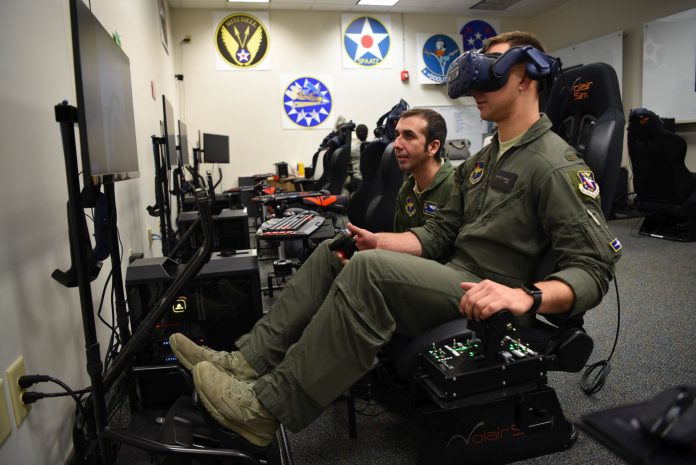
COLUMBUS AIR FORCE BASE: Columbus Air Force Base’s innovation flight has continued its efforts to integrate virtual reality (VR) technology into pilot training, creating quality pilots for the Air Force faster.
The innovation flight created a flexible syllabus containing the essential building block approach of basic mission elements to accommodate each student’s different learning habits while still hitting the intangible aspects of a successful aviator.
Lt. Col. Christopher Harris, 41st Flying Training Squadron chief pilot and director of the innovation flight, said students from the flight have executed the training requirements slightly faster than the average pilot in the normal syllabus. He also said one notable difference was the completion of the syllabus track for a T-1 Jayhawk. Where the traditional student has completed the syllabus in 47 aircraft sorties, the innovation flight’s quickest student completed it with only 42 sorties while passing all the same standards as the traditional students.
The innovation flight aims to cultivate skills such as situational awareness, risk management, decision making and to augment the training student pilots go through. To do this, the flight incorporates modern technology aiding the student pilots throughout the training process.
The innovation flight incorporates virtual reality tools, such as the Oculus Go, into its syllabus to make pilots more prepared and to help drive the student’s airborne training farther.
“The real link to improving mission effectiveness at the base level starts in the classroom where we make the students better faster, have instructors who are free to provide airborne instructions to more advanced students, and drive the warfighting capabilities the Air Force needs,” Harris said.
With the help of VR equipment, students see the things they would normally see in an aircraft while being able to follow their procedures as the class instructors provide feedback and grading.
“Being a new pilot in training, visual references are a big part of doing patterns,” said 2nd Lt. Matthew Demarco, 14th Student Squadron student pilot. “My flight got into the VR flight simulations early, so we had a head start going into things. Even though VR does not simulate the feeling of the aircraft, the way you can see the visual references and getting to interact with the instruments used in departures and landings made it easy to progress throughout the rest of the training.”
In the VR simulation, students can practice everything from starting up the aircraft to landing it. The ability to use this tool extends the students familiarity with the aircraft they are going to fly before they step foot in it.
Demarco said sometimes having additional sensory inputs during an aircraft flight can be overwhelming while learning basic maneuvers, but by using the VR equipment a student has the option to pause the flight, look around and then continue which is a luxury not available in a real training mission.
“You can see real life problems that might occur in the sortie, this gives insight to what you can expect while in a real flying training exercise,” Demarco said.
The innovation flight is exploring ways to utilize virtual reality tools to help students stay on track with extended breaks due to things like weather, maintenance, transitioning to new phases or even holidays.
“There are some things the VR is good for and some things it is not,” Harris said. “The VR does not replace actual flight training, but what we do here at innovation flight is to try and leverage the things that it is good for. We then place it into the appropriate spot in the syllabus, continue to evolve as the technology develops and create better pilots faster.”
Using the advanced VR gear located inside the classrooms, Columbus AFB can focus on keeping its experienced instructor pilots out on the flight line to train students in the skies.
from Defense News by DefenceTalk.com https://ift.tt/3bMw4Bq
via Defense News
No comments: